Translated By Andrew Yang
Question: How do you promote Buddhism in a Muslim country, so that Buddha’s holy teachings benefit as many beings as possible?
Answer: First, it must be stated that while Islam is Malaysia’s official religion, in substance it is not an Islamic country. Furthermore, the task of purifying the people’s minds cannot be done by any religion or single race alone. With Buddhism, which is based on compassion, we work out of love to encourage fusion and harmony. While fostering mutual understanding and respect among different ethnicities, cultures and religions, we maintain good contact with the government and, on a macro level, cultivate respect and solidarity with all other religions and races.
In 1970, we established Malaysian Buddhist Institute under the initiative and leadership of our founding president Venerable Chuk Mor, and have worked hard since then on Buddhist education. For five decades, our institute has had a considerable impact on Buddhist education throughout Malaysia, and it has become a priority for the association. According to our numbers, 80% of all Malaysia’s Buddhist monks and nuns have trained at the institute. It now offers novice, junior, medium, and advanced-level Chinese courses in Buddhism on campus and by correspondence. Each year more than a thousand students across the country take the national examination held on National Day, and our various short-term Buddhist study and hobby classes have also attracted many enthusiasts. In addition, we run nursing homes, conferences for Buddhist teachers, and a free medical clinic. To be able to adapt to the changing times and needs, we routinely adjust our programs, courses and pedagogy. As well, we invite outside experts and cooperate with other institutions in jointly promoting the Dharma, which is a good way to encourage exchanges between different Buddhist bodies and together grow impact for Buddhism.
At the association, our departments of youth, education, Dharma promotion and charity all take the initiative to connect and co-sponsor events with fellow Buddhist organizations, thus deepening cooperation and networking. Nowadays, this approach has become popular for organizing events, since it both saves resources and improves communication among different groups.
Youth are the future of Buddhism. But in their Buddhist education, the one difficulty we face is that we find youth activities today no longer have much appeal. But youth activities can’t just be for pleasure. There have to be a Dharma element. So what we now do is to hold joint events with other organizations. We try to innovate and ask team leaders what kind of correct world outlook can be introduced in a particular activity. As long as that is appropriately implemented, everything else can be done to accommodate youth preferences. We are also trying to make use of youth theme parks to host events, incorporating Dharma elements into popular youth activities such as physical exercise and teamwork. In addition, we are trying to have outdoor classes at tourist attraction spots and teach the Dharma while enjoying the sights. The challenge that youth pose to us is the need to be continuously innovative.

Question: Approximately how many young people have become monks through these programs?
Answer: The purpose of organizing Buddhist study activities for young people is to help them shape a constructive understanding of the Dharma. As to whether eventually they do become monks, frankly, we rarely see it happen, but that is not our objective.
Our objective is to help young people acquire a robust knowledge of Buddhism, which hopefully will be a benefit in helping form their outlook on life later on, so they understand that Buddhism is not merely worshipping, nor is it just rituals for the dead. I hope that eventually these programs will help steer their paths of life in the right direction. In the end, whether they inspire them to the extent that they turn into monastics, that is certainly our hope, but it cannot be forced.
Question: So who are Malaysia’s new monks and nuns now?
Answer: There are two groups, those who were children formally adopted and raised by the temples, and those who have been consistently involved in Dharma activities for a long time. However, for various reasons, be they family, compulsory education or something else, it is true that few under forty actually become monks in Malaysia.
Now the problem seems to be that there are many temples but few monks, and everyone tries to bring their disciples back to their own temple so it can survive. In the meantime, I am afraid the crucial Buddhist cultivation of these disciples may have been neglected. However, it’s okay to have just a few monks. As long as they are well nurtured, nonetheless, they will make a real difference to Buddhism and Buddhist education in Malaysia.
Question: Looking ahead, what are the prospects for Buddhism in Malaysia?
Answer: Aside from cultivating young people, the job of promoting the Dharma fundamentally depends on the virtuous decency and admirable dignity of the renunciates so that, when manifested, people interacting with them experience joy and awe.
In addition, cultivate-at-home lay Buddhists should be the source of new monastic candidates. We must pay close attention to their education and guidance so they appreciate that the Dharma has a critical, positive impact on life.
We are convinced that those engaging in the cause of Buddhism are all filled with compassion. With the improvement of their own Dharma cultivation and the power that the Three Gems and high tech afford us, everyone will work together and do a good job in promoting Buddhist education. If we persist in it for years and decades, we will be able to open a bright new sky.

